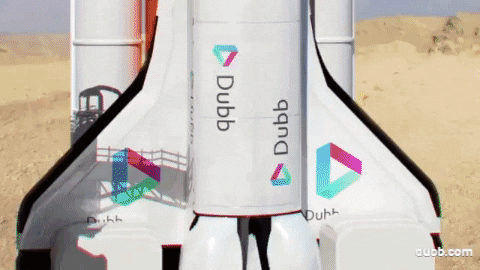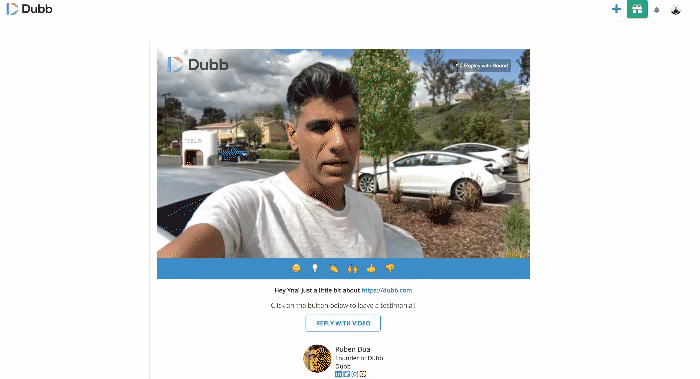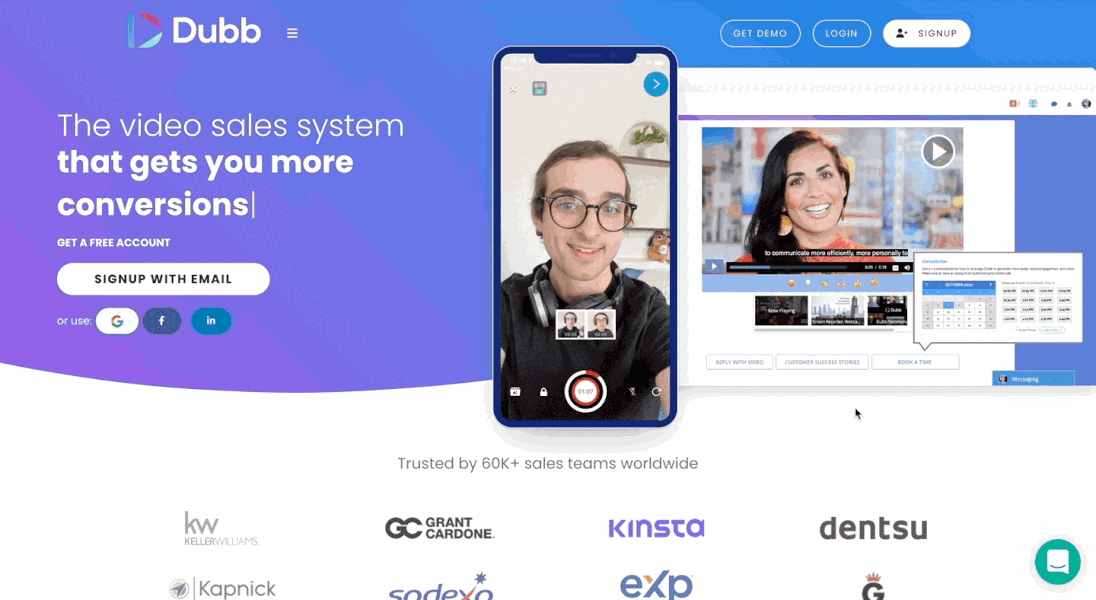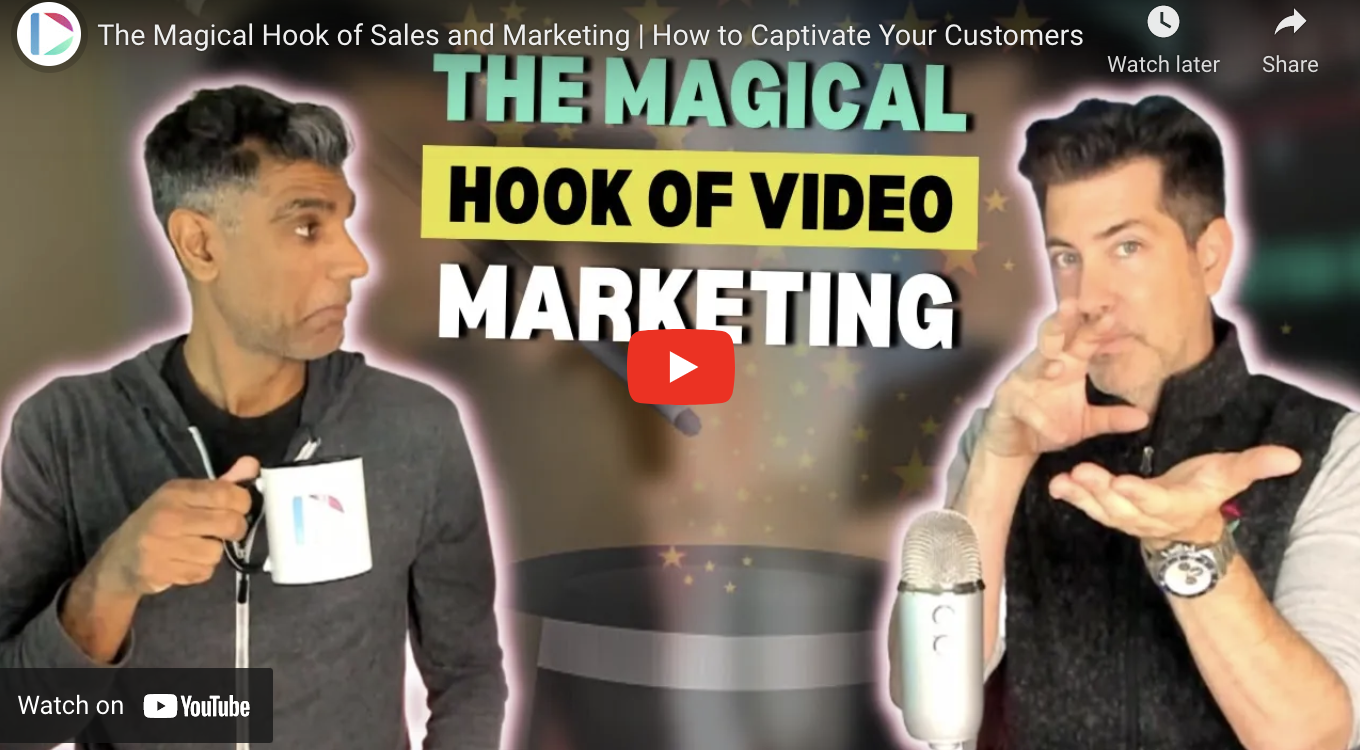A magical hook is critical for helping your sales message stand out in a crowded world. It can be just the thing you need to separate your business from the competition, build stronger relationships with your prospects and customers, and generate more sales.
With that being said, let’s take one step back. Ask yourself this one simple question: what do a YouTube video, a sales department, and a great song all have in common?
The answer, as you probably guessed, is a hook. Yet the more interesting thing is the fact that I asked you that question. That question about a hook was actually a hook itself. I’ll get into this more later in the post, but it goes to show how a great hook can build intrigue and curiosity, which can ultimately lead to a positive outcome for you and your company.
The magical hook of video sales and marketing is a big deal. It is such a big deal that it can make the difference between missing your sales goals and hitting your short-term and long-term sales goals. Whether you are a solo entrepreneur or a sales leader at a much larger company, you can absolutely rely on a magical hook to hit your sales and marketing goals.
Ultimately, the best time to get started is right now. You can develop and capitalize on a magical hook to supercharge your business.
Let’s get started.
This blog post is a recap of a recent episode of RevShow, which is Dubb’s YouTube show on all things related to sales, marketing, video, and accomplishing your business goals. If you would like to learn more about the show and get updates on future episodes, feel free to click here.

Applying 19th Century Magic to Today
Think about this: we are living in a total culture of noise. The noise is there whether you are physically walking down the street or are surfing the web. It has become increasingly difficult to find silence in our day-to-day lives. We need to deliberately seek out silence because noise is the default in today’s day and age.
Moreover, that noise is coming from every single possible angle. On an average day, you are probably inundated with emails, SMS messages, advertisements, videos, and more. Granted, all of this noise isn’t harmful or worthless. An email or SMS message can be entertaining, funny, and a great breakup to the stress and busyness of your day. With that being said, the vast majority of noise is just that—noise. It can be extremely distracting and can prevent us from reaching our personal and professional goals. Moreover, it can be overwhelming. Right when we do want to concentrate and get our work done, the incessant noise can throw us off track for days or even weeks at a time.
For sales professionals, it can be difficult to think that we are part of this noise. After all, we are confident advocates for the products or services that our companies sell. That being said, for CEOs and other key decision-makers at our target firms, we may be thought of as noise. Their schedules are obviously full. In most circumstances, they are managing large groups of people. Therefore, as they are trying to manage their colleagues and get important tasks done, it becomes extremely easy for them to forget about (or even ignore) your sales pitch. With too many things on their minds, it becomes all too easy for them to think of your pitch as noise.
With all of that said, how do we punch through the noise? How do we intrigue our targets so much that they not only remember our pitches, but they feel compelled to purchase our products or services?
The answer is through the magical hook.
You can think of the magical hook like Christopher Nolan’s awesome film The Prestige. If you haven’t heard of The Prestige, it is an excellent film starring Christian Bale, Hugh Jackman, and Scarlett Johansson. The IMDB description alone is extremely compelling:
In the end of the nineteenth century, in London, Robert Angier, his beloved wife Julia McCullough, and Alfred Borden are friends and assistants of a magician. When Julia accidentally dies during a performance, Robert blames Alfred for her death, and they become enemies. Both become famous and rival magicians, sabotaging the performance of the other on the stage. When Alfred performs a successful trick, Robert becomes obsessed trying to disclose the secret of his competitor with tragic consequences.
The Prestige is an awesome movie about magic, illusions, and why things in life aren’t exactly as they seem. But at the same time, The Prestige shares some extremely valuable lessons that we can apply in our sales and marketing lives. One of those lessons involves the magical hook. Even if you don’t know anything about magic (or don’t care about magic), the magical hook as described in The Prestige can accelerate your business.
Magic Tricks and A Magical Hook
When we think about this idea of a magical hook, we think about the way to set up a magic trick. To put it another way, every magical hook has some sort of magic trick embedded in it.
If you have seen The Prestige, you know that there are three parts to any type of magic trick. You need all three elements to make the magic trick work. Specifically, the first part of the magic trick is the pledge. The second part is the turn. The last part is the prestige.
The pledge is when a magician shows you something ordinary. It is also about pledging to do something with that ordinary thing. For instance, I can pull out a Dubb mug. You recognize that the mug looks like any ordinary coffee mug. After you see the mug, I can tell you that I am going to make the mug disappear. This is all included within the pledge and is the introductory portion of the magic trick.
After the pledge comes the turn. The turn is when you take the ordinary object and actually follow through with what you promise. It is an extraordinary feat—even though the audience is actually expecting it to happen. Going back to the Dubb coffee mug example, when I actually make the mug disappear, that is the turn. I promised to make the coffee mug disappear and I actually followed through.
Then, there comes the prestige is all about the above and beyond. It is going beyond the promised trick and doing something that the audience doesn’t even think about. So turning back to the coffee mug example, at this point, I made the Dubb coffee mug disappear. The prestige would be having the Dubb coffee mug reappear. It is the payoff of the entire magic trick and arguably the most satisfying part of the entire experience. It is also the hardest part and the step that tests every novice and expert magician.
So these three steps make up any type of magic trick. When we are talking about the magical hook of sales and marketing, you will need to keep these in mind. As I will describe shortly, you will need to execute on each step to take advantage of this strategy and reach your sales and marketing goals.
Applying the Magical Hook of Sales
The Prestige is a fantastic film. If you haven’t seen it yet, I highly recommend that you do so. Whether you are or aren’t interested in the film, however, you may be wondering how this discussion of magic tricks and magical hooks is relevant to your sales and marketing work.
This is where the discussion really pays off. The great news is that you don’t need to be an expert magician to capitalize on this strategy. You don’t even need to have seen The Prestige or heard about the magical hook of sales to move forward.
It is pretty simple.
The magical hook is rooted in the delivery. It is about going above and beyond the pledge and the turn. At its core, it is about the prestige and providing value that your audience or customer wasn’t even expecting in the first place.
Let’s break this down a little bit more by going through all three elements of a magic trick. By applying them to a sales context, you can see how to leverage them in your day-to-day sales work.
As you can guess, we are going to start with the pledge. To remind you, the pledge is the promise. As the magician, you are showing your audience something (typically, an object) and explaining what you are going to do with it. So in the sales context, the pledge is focusing on your audience and explaining how your product or service can improve their lives. It is essentially saying, “Do you have a problem with X, Y, and Z? I can help you solve that.”
In the sales context, the pledge is about getting to know your audience and explaining how your product or service can solve a specific problem. In effect, you are making a promise and the audience is expecting you to fulfill that promise.
Now, let’s talk about the turn. As I described above, the turn is the part where you are actually delivering on the thing that you promised. It is the result that the customer gets. In other words, it is the answer to that question above (“Do you have a problem with X, Y, and Z”).
Most businesses focus on the turn. There is a good reason for this, as it is the follow through from what the business or organization was promising. For instance, if I worked for McDonald’s and promised that I would deliver the classic McDonald’s fries that we all know and love, the turn would be you receiving those golden, delicious french fries.
In the sales context, however, there is a little bit more to the turn. When it comes to the turn, there are three important things. Those three things are the proof, action, and results.
The proof is where it all becomes real. In our coffee mug example from above, it is when you see the coffee mug disappear. The proof is there: you saw the Dubb coffee mug in one instant, and in the next instant, it was gone. Metaphorically, it is when the magician pulls up his sleeves, opens up his pockets, and shows that this is real. When this process happens, the audience members are impressed. They see the proof in front of them and are wowed by what transpired before them.
Oftentimes, the magician will ask audience members, “Have I paid you? Have you ever met me before?” This is all social proof and works to make the turn that much more impactful. Think about it: if the magician didn’t ask audience members whether they were compensated or in on the turn, others would wonder whether the entire thing was fixed. It would make the entire magic trick and magical hook much less effective. This is why we often see magicians move forward and ask this important question to members of the audience.
Social proof isn’t enough, however. There needs to be some sort of action. There needs to be something real and something that shows the result of the magician’s actions. Businesses need to keep all of this in mind as they are leveraging the turn in their sales efforts. Granted, they don’t need to always ask whether others have been compensated for their kind words about the product, service, or company. At the same time, they do need to show some sort of proof that they can deliver on what they promise.
The prestige, however, is where the person is truly delighted. They are delighted above and beyond their initial expectations. In other words, the prestige is basically the idea of under-promising and over-delivering.
So if you take a back, you can see that the magical hook is all about making a promise, delivering on that promise, and building a relationship. You can see the power of the magical hook by simply looking at the video above. At the beginning of the video, we provided a hook. We presented a problem and then gave a solution to that problem. Now, what we are hoping to do is deliver upon that promise and (hopefully) give you a prestige.
Now, let’s talk about the prestige. The prestige is about bringing the extraordinary into the world. It’s essentially shocking the audience and having them thinking, “Wow! I did not see that coming. I am so impressed.” The audience members may have thought the entire magical hook was over, but you or your company went one step beyond and did something that they truly were not expecting.
What you are doing here is surprising someone with something valuable and extraordinary. On one level, it can be information. For instance, you can provide a customer or prospect with extremely valuable information on how to get more from your product or service. That information could actually help your customer save money—even if it affects your bottom line. While you may take a temporary financial hit, the goodwill and sheer awe that you deliver to your customer will likely result in more sales down the road.
But beyond pure information, the prestige can be something that you actually do for the customer. There are plenty of examples of this (which I will discuss in further detail below). The simple reality is that actions speak much louder than words. If you can do something that utterly wows the customer, you will have that person in your hand. In terms of your messaging, you have them captive. Along with this, you are delighting that person. The synapses in their brain are firing and they are excited. They implicitly recognize that you and your business are different from your competitors. While your competitors may have stopped short and delivered only what their customers expected, you differentiate yourself by going above and beyond. You truly surprise and delight your customers through the prestige and make it much more likely that they will remain customers for the foreseeable future.
Last (but certainly not least), the person who has witnessed the prestige is more inclined to spread the word about you and your business. In the sales context, this comes in the form of referrals. If you have watched RevShow or have read any of our blog posts, you undoubtedly recognize that we absolutely love referrals. Referrals and this general idea of word-of-mouth marketing can accelerate the course of your business. And using a tool like Dubb’s reply with video call to action, you can easily gather video testimonials from your most satisfied customers and fans. Ultimately, if you can deliver a prestige, you are in a fantastic position to delight your audience and delight many more prospects and customers in the future.

Case Study #1: My Experience With Tesla Motors
To better explain the magical hook in a sales and marketing context, I want to share a brief story from my life. The story is about my Tesla and it is all rooted in sales and customer experience. As you will see at the end, Tesla delivered a prestige and made it much more likely for me to recommend their car and services to other people.
The story starts with me needing to fix my Tesla. I was having an issue with the screens in my car, so I reached out to Tesla to find a solution. From there, I went to the Tesla service department and said that I wanted my screens updated. The Tesla representative said they would do it for me, but it turns out that they made a mistake. They gave me the wrong parts (which cost me a bunch of money and a bunch of time).
However, when I went back to the dealership, the Tesla team made amends. They actually gave me a full media upgrade and an awesome loaner vehicle for about two weeks. I wasn’t expecting that and was blown away by the process. Not only did they promise, but they delivered. They went above and beyond—even though they didn’t necessarily have to.
The fact that Tesla went above and beyond transformed into a story that I’m telling you now. That shows the power of the magical hook. The scenario could have gone several different ways. In the worst scenario, Tesla could have kept failing to solve the problem and directed me to another mechanic to fix the problem. Obviously, analogizing this to other business contexts, we want to avoid this type of encounter. It will definitely turn off your customers and essentially kill off the underlying relationship. In another scenario, the Tesla representative could have simply fixed the problem without giving the full media upgrade. This would have been Tesla executing on the pledge and turn (albeit, late). However, there is no prestige there. They would have missed an opportunity to completely blow away my expectations and deliver an experience that I wasn’t expecting.
A magical hook cannot occur without a prestige. However, when the prestige exists, amazing things happen. A magical hook can lead to satisfied customers and satisfied customers can lead to referrals. You really get to leverage a multiplier effect. By delivering a magical hook, you gain a better chance of getting repeat business from that customer and getting business from customers that you may not even know of. Pretty great, right?
So for all of the sales leaders out there, you should take the magical hook and implement it into your business. Understand that what you are creating is a movement with a simple, unified message. It’s especially powerful if you integrate this attitude throughout your business. Tesla certainly does. For instance, let’s say that I’m excited about showing you my Tesla. I may show you this cool feature where I can take my key, walk in front of any other person’s Tesla, and have that specific Tesla’s lights click. That quick experience may hook you. Once you learn about Tesla and the cool features that its cars have, you may tell other people about that experience. Tesla understands this effect and doesn’t hesitate to include plenty of easter eggs within their vehicles. It is yet another way to surprise, delight, engage with, and sell to your customers.
Tesla’s simple message unifier is that technology can be fun. This message multiplies and becomes ingrained within the Tesla ecosystem. Even if your company doesn’t have the resources or scale that Tesla has, you can certainly adopt this strategy and incorporate it within your sales process.
Case Study #2: Michael Jordan and Nike
One of Rob’s favorite NBA players is Larry Bird. Bird had a legendary career, with over three NBA championships and more than 20,000 total points in his career. That being said, Rob recognizes that Michael Jordan is the greatest basketball player to ever play the game.
When we say Michael Jordan’s name, Rob first thinks about Jordan as a player. You don’t need to have watched The Last Dance to know that Jordan reached the pinnacle of the sport. Even though there may be some debate about whether Jordan or LeBron James is the best basketball player of all time, it’s safe to say that we will be talking about Jordan for centuries to come.
But if you aren’t into basketball, you may hear Jordan’s name and immediately think about sneakers. When Jordan’s first Nike sneakers came out in the 1980s the force/message multiplier was the actual sneakers themselves. Sure, people knew that Micahel Jordan had a huge role to play in making the sneakers. However, it was the Nike swoosh and the Jordan Jumpman symbol that was the force multiplier. So when you saw those sneakers, you could literally see the magical hook of Nike spreading throughout the world.
People like Rob buy Jordan sneakers for hundreds and hundreds of dollars for each pair. If you observe the market and really think about it, these Jordan sneakers become collector’s items. Through this, Jordan sneakers have become a movement. In fact, it has become a multi-billion dollar movement based on a simple message.
That message? If you wear these shoes, you get air.
So what can we learn from this case study? Ultimately, Nike has a magical hook through the Jordan brand sneakers. It has a pledge to deliver comfortable, stylish sneakers for its wearers. The turn is Nike actually delivering on that promise. The prestige, however, is the fact that wearers of Nike shoes get to join a movement. That movement is something that you can’t quantify, yet is something that provides real value to every single member of that community. Nike’s magical hook is something that it has had for decades, and it will continue to have it for the foreseeable future. Simply put, there is a lot going on beyond the Nike swoosh and the Jordan Jumpman logo.
Going Forward With Your Magical Hook
In the end, you and your business need to recognize your magical hook. While it may be difficult to identify or build at first, I believe that every company can take advantage of this strategy. Your magical hook is there for the taking, so make sure that you are searching for it.
As I mentioned, the video above was a great example of a magical hook. I started by asking what a YouTube video, a sales department, and a good song all have in common. The answer was that they have a hook. At the same time, I hope you’ve gathered plenty of insights and other advice that you may not have necessarily expected going into the video.
In sum, if you are a sales leader within your sales department, find your hook and use it. The same is true if you are a solo entrepreneur, CEO of your company, or even a junior member of your sales team. And when you are creating your magical hook, think about your opening (the pledge), the delivery (the turn), and the wow factor (the prestige).
The magical hook of sales and marketing can certainly help you accomplish your sales goals. Whether you are a sales leader at a large organization or are an entrepreneur trying to get traction for your new venture, you can rely on the lessons in this post to see the results that you want to see. Considering all of this, keep these lessons in mind. Aggressively execute. By doing all of these things, you are setting yourself up for success. I wish you the best of luck!

At Dubb, we love talking about the magical hook of sales and marketing, video marketing in general, and other fascinating topics related to marketing and sales. If you would like to learn more about how Dubb can help you leverage the magical hook of sales and marketing (and other sales and marketing tactics), go ahead and click here. We also invite you to click here to contact us and click here to get a free 14-day trial of our premium plans.


